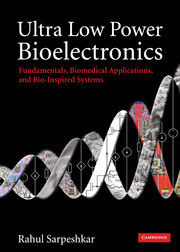Book contents
- Frontmatter
- Contents
- Acknowledgements
- Section I Foundations
- Section II Low-power analog and biomedical circuits
- Section III Low-power RF and energy-harvesting circuits for biomedical systems
- Section IV Biomedical electronic systems
- Section V Principles for ultra-low-power analog and digital design
- Section VI Bio-inspired systems
- Section VII Energy sources
- 25 Batteries and electrochemistry
- 26 Energy harvesting and the future of energy
- Bibliography
- Index
- Epilogue
- References
26 - Energy harvesting and the future of energy
from Section VII - Energy sources
Published online by Cambridge University Press: 02 December 2010
- Frontmatter
- Contents
- Acknowledgements
- Section I Foundations
- Section II Low-power analog and biomedical circuits
- Section III Low-power RF and energy-harvesting circuits for biomedical systems
- Section IV Biomedical electronic systems
- Section V Principles for ultra-low-power analog and digital design
- Section VI Bio-inspired systems
- Section VII Energy sources
- 25 Batteries and electrochemistry
- 26 Energy harvesting and the future of energy
- Bibliography
- Index
- Epilogue
- References
Summary
Nature uses only the longest threads to weave her patterns, so that each small piece of her fabric reveals the organization of the entire tapestry.
Richard P. FeynmanEnergy surrounds us, is within us, and is created by us. In this chapter, we shall discuss how systems can harvest energy in their environments and thus function without needing to constantly carry their own energy source. The potential benefits of an energy-harvesting strategy are that the lifetime of the low-power system is then not limited by the finite lifetime of its energy source, and that the weight and volume of the system can be reduced if the size of the energy-harvester is itself small. The challenges of an energy-harvesting strategy are that many energy sources are intermittent, can be hard to efficiently harvest, and provide relatively low power per unit area. Thus, energy-harvesting systems are usually practical only if the system that they power operates with relatively low power consumption.
We shall begin by discussing energy-harvesting strategies that have been explored for low-power biomedical and portable applications. First, we discuss the use of strategies that function by converting mechanical body motions into electricity. A circuit model developed for describing energy transfer in inductive links in Chapter 16 is extremely similar to a circuit model that accurately characterizes how such mechanical energy harvesters function. Thus, tradeoffs on maximizing energy efficiency or energy transfer are also similar.
- Type
- Chapter
- Information
- Ultra Low Power BioelectronicsFundamentals, Biomedical Applications, and Bio-Inspired Systems, pp. 822 - 858Publisher: Cambridge University PressPrint publication year: 2010
References
- 1
- Cited by



